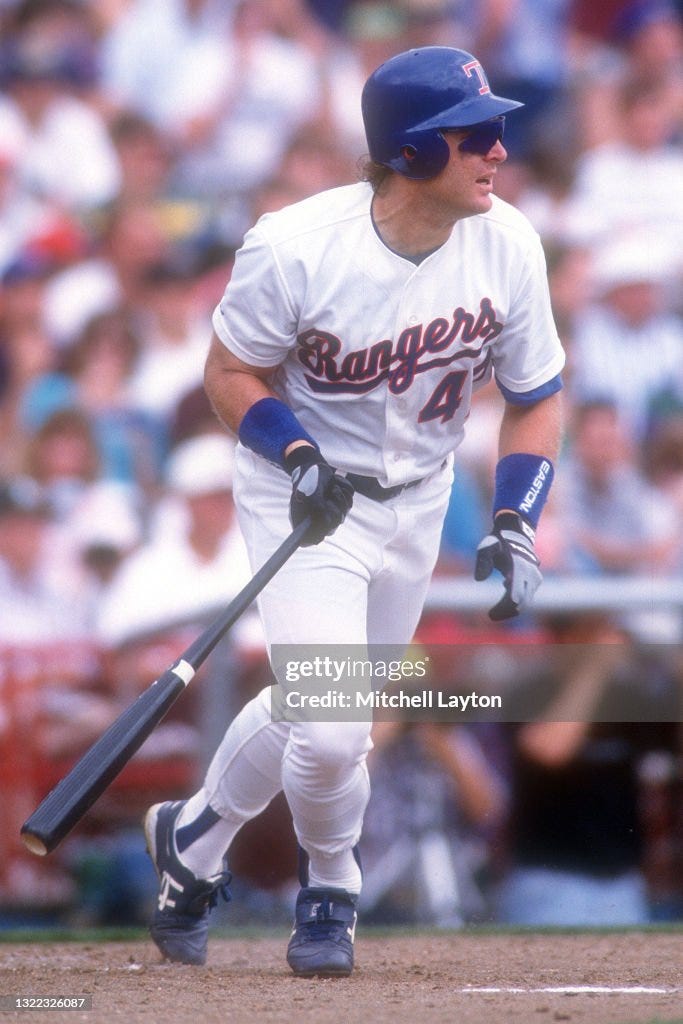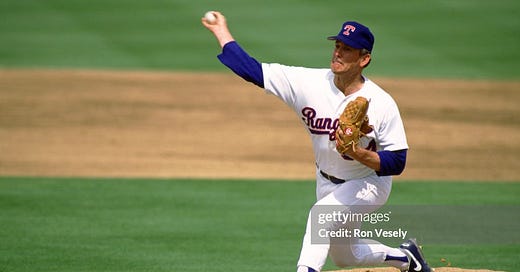My post on my favorite baseball movies from two weeks ago gave me an idea. No, The Good, the Bad, and the Ugly is not a baseball movie (if it was, my money would be on Tuco), but maybe I can adapt the title for my own purposes. I thought it might be interesting to pick three random teams from between 1985-94— one good, one average, and one terrible— and take a closer look at each of them in a three-part series. The fact that all three of them are from the 1991 season is just a happy coincidence, but I think it worked out well. This is part two, the Bad. Or perhaps, more accurately, the mediocre.

The Bad: 1991 Texas Rangers
Okay, before we even get started, I have to ask this question. How in the hell were Rangers not a better team? I’m not even talking specifically about the 1991 team, but the Rangers of the early 90’s as a whole. It’s a question that comes to mind every time I play with them on Ken Griffey Jr. Presents Major League Baseball on the SNES (yes, I’m still playing that game— see the archive for more on that), and it was the first thing I thought of when I started researching this team.
Sure, the 1991 team was not quite as loaded as the 1993 version that is forever immortalized in Griffey’s SNES game, but in a year that the A’s (who had gone to three straight World Series) fell back to the pack, the Rangers had every opportunity to grab the AL West for themselves. On paper, they had the guns to do it, but it never came together in real life.
Maybe it had something to do with the manager. Bobby Valentine was a talented baseball man who took over in 1985 and finished second in the AL Manager of the Year vote in 1986, but had his greatest success in Japan. Unfortunately, the Rangers play in Texas.
Probably best known for sneaking back into the dugout with a pair of fake glasses and a mustache after being ejected from a game during his later Mets tenure, 1986 was his peak in Arlington. They finished second in the AL West that season, but he never finished higher than third after that, and was let go during the 1992 season.
The Rangers finished third in 1991, with a record of 85-77, ten games back of the eventual World Champions, the Minnesota Twins. They finished fourth in 1992, second in 1993, and were leading the division when the Strike shut everything down in 1994, albeit with a record that was ten games under .500. So it wasn’t like they ever really clicked. It was just that the smaller, realigned AL West was that bad.
It puzzled me at the time, and it still puzzles me now. Take a look at what they were working with and see if it makes any sense to you.
Let’s start with the pitching. The headliner is, of course, Nolan Ryan. Something else that boggles my mind is that there’s currently a very vocal minority online that believes Ryan was overrated. Sure, he had some holes in his game, I’m not calling him the greatest pitcher ever, but that’s nonsense. If the stats and the records he holds don’t convince you, I saw the man pitch, and he was absolutely not overrated. And I wasn’t even old enough to catch his prime.
By 1991, Ryan was basically the Methuselah of baseball, but he was showing few signs of slowing. On May 1, he threw his record seventh and final no-hitter against Toronto. Later that season, he recorded his 5,500th career strikeout against Tino Martinez. He finished the season with a 12-6 record, 2.91 ERA, 203 K, and 1.006 WHIP. So I don’t want to hear any of that Nolan Ryan was overrated crap.
True, the rest of the Rangers 1991 staff had its shortcoming. Kenny Rogers (no, not that one) had not yet rounded into form, and Kevin Brown, who would eventually supplant Ryan as the ace of the staff and have a borderline HOF career, had a bad year, finishing 9-12, with a 4.40 ERA. Bobby Witt Sr. did not have the talent of his son, and Oil Can Boyd was washed. But it wasn’t all bad. Jose Guzman put together a 13-7, 3.08 ERA season on his way to winning the Comeback Player of the Year award.
But pitching was never where the Rangers true strength lay. Texas was always built around offense, and its lineup could hold its own with anyone.
Juan Gonzalez was the biggest name on the lineup card, although he was still finding his footing in the Show in 1991. It was his first full season, and while his best years still lay ahead— he went on to win AL MVP awards in 1996 and 1998, and claimed two AL HR titles— he was already a force to be reckoned with. Sure, I wasn’t seeing his name in the morning paper yet when I checked the HR leaders to see if Mark McGwire was leading the pack, but he was already announcing his presence.
Gonzalez (1991): .264/.321/.479, 27 HR, 102 RBI, 34 Doubles, .800 OPS, 121 OPS+
Gonzalez became just the eighteenth player in MLB history to have a 100 RBI season before turning 22, and as I said, even better things were on the way. At his peak, he was one the most dominant sluggers I’ve ever seen. But he was far from a one-man show with the Rangers. He had lots of help.
Julio Franco won the AL Batting Title with a .341 average, and Rafael Palmeiro led the AL in doubles with 49. Steve Buechele, a solid enough 3B, was traded to the Pirates after 111 games, opening up a spot for Dean Palmer, who hit 15 HR in less than half a season. He would later add his name to the paltry list of Royals players to hit 30 HR in a season, so my cousin and I still refer to him as “Royals Legend Dean Palmer.” It’s mostly in jest, but how can you not like Dean Palmer?

A rookie by the name of Ivan “Pudge” Rodriguez took over duties behind the plate that season, playing in 88 games. Pudge was hardly at the height of his powers in 1991 either, but over time he established himself as one of the best catchers ever and a Hall-of-Famer. The Rangers also boasted Kevin Reimer at DH. Reimer is, for some reason, one of the most dominant players in SNES Griffey. It doesn’t make much sense, but, if you remember him at all, he was better than you probably recall. He put up 20 HR and 69 RBI in 1991.
Ruben Sierra was still viewed as the face of the franchise in RF, recording 25 HR and 116 RBI in 1991. He was traded to Oakland a year later for Jose Canseco, who should have added another big bat, but Canseco’s Texas tenure is more like a blooper reel. Neither he or Sierra were ever as good with their new teams as they were with their old ones. Who knows why?
And that pretty much sums up how I feel about the Rangers of the early 90’s. Am I wrong? I mean, if you were building a roster, I feel like you could do a lot worse than the pieces assembled by the Rangers. But for whatever reason, it never fit together.
Baseball can be mysterious like that.
Thanks for reading Powder Blue Nostalgia. Any thoughts on the Rangers of the early 90’s? What other teams stand out to you as middle-of-the-road underachievers? Leave your picks in the comments.




Patrick,
You are right, hearing the names you mentioned with the Rangers in "91" you would have thought they would have done better. But as you said, baseball is a funny sport, sometimes a team just doesn't jell, lack of leadership, majurity, timing, etc.
While back in Kansas I picked up the powder blue Royals T-shirt, Kansas Jayhawks & Chiefs T-shirts. Just in time for the Kansas upset of Oklahoma, wore my KU T-shirt proudly Sunday. 😉
As always, enjoyed the read! Thanks